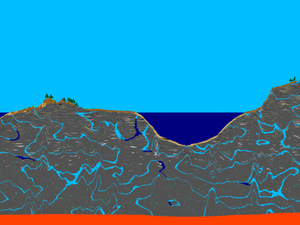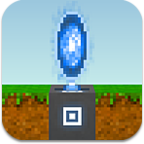World

Each world has biomes, climate zones, poles, an equator, and celestial objects that can be seen especially in the clear night sky.
All worlds are randomly generated; no two worlds are alike. The location of the spawn portal is different in each world. However, one can generate two worlds with the same structure through the use of custom rules, if the same seed is used to generate both worlds. All worlds have landmarks such as the poles and equators.
Size
All 1x worlds are 16,384 blocks in circumference and roughly 1024 blocks from magma to space. 1/16x, 1/4x, 4x, and 16x worlds are respectively 1024, 4096, 65,536, and 262,144 blocks in circumference. 16x worlds can only be created though servers. Sea level is roughly 512 blocks from space and 512 blocks from magma. As the height of magma will vary, the distance from magma to sea level or space will also vary.
The ability to create 4x and 16x worlds through servers was introduced in version 1.5. The ability to create 1/16x and 1/4x worlds (as well as singleplayer 4x worlds) was introduced in version 1.6.1.
Structure
Although The Blockheads is mostly two-dimensional (up, down, left, and right), a certain amount of "depth" is visible. The effect is as if there are four layers of depth:
- Foreground - Where solid and liquid blocks and blockheads exist. A blockhead can move through fluid blocks (air and water), but not solid ones.
- Mid-ground - Where most objects that a blockhead can move past exist, such as trees and crafting surfaces. Blocks in the foreground have a presence here as well.
- Background - Where any "backwall" blocks or objects exist. A block that's only in the background can be acted on to have a mid-ground ore foreground object placed on it. Most foreground blocks have a presence in the background behind it and all non-solid blocks below it until interrupted by another solid block.
- Sky - Where celestial objects exist.
Bedrock
Below a certain point, the default background layer ceases to be air and becomes stone, preventing any other block from displacing it. This background is present even if no solid blocks are anywhere above it, and usually is initially created where the overlying layers of dirt and sand stop and underlying stone begins. As such, this can be called the world's "bedrock." Starting in version 1.6, this wall can be removed with a pickaxe if certain conditions are met.
Bedrock also extends directly underneath the initial portal until it merges with the natural bedrock of the world.
Display
The visible world can be displayed at any of six scales, three of which can be used to interact with a blockhead. They can be changed between by two-finger sweeps (pinching and spreading).
- Default - Blocks are displayed at the same size as the inventory icons on the right of the display.
- Small - Blocks are tiny, allowing more of the world to be viewed at one time.
- Large - Blocks are large, allowing more detail to be seen and tapping to be more accurate.
While using a camera, the zoom level can be fine-tuned to levels in between the three main levels as well as much "closer" to nearly fill the display with a single block face.
Additionally, there are three levels beyond "Small" that eliminates details and reduces individual blocks to small, square pixels. The display can be scrolled vertically or horizontally, and the effects of night (but not underground illumination) are eliminated. At maximum zoom-out, it's roughly possible to see from magma to space without scrolling. In any of these modes, portals are superimposed with a larger than scale icon and blockheads are positioned by name.
The exact amount of a world that can be seen at one time depends on the device and scale used.
Known World
Only those areas seen previously are visible. Any changes are also visible, even if a blockhead is not near the area being viewed. Server admins and owners can see all areas explored by any player.
Updating
The animals and plants of a world are not static, but continue with their activities even when nothing else is nearby. To conserve system resources they may not be updated in detail unless they are actively viewed by a player. This can result in some interesting effects, such as large trees despawning into a pile of sticks and wood or an ocean waiting until the arrival of a blockhead to begin draining into an open submarine cave.
Worlds started with an earlier version of the app may have new features added when opened in newer versions. This has been noted particularly with the addition of black sand (version 1.4) and the appearance of trade portals in troll lairs (version 1.5).
